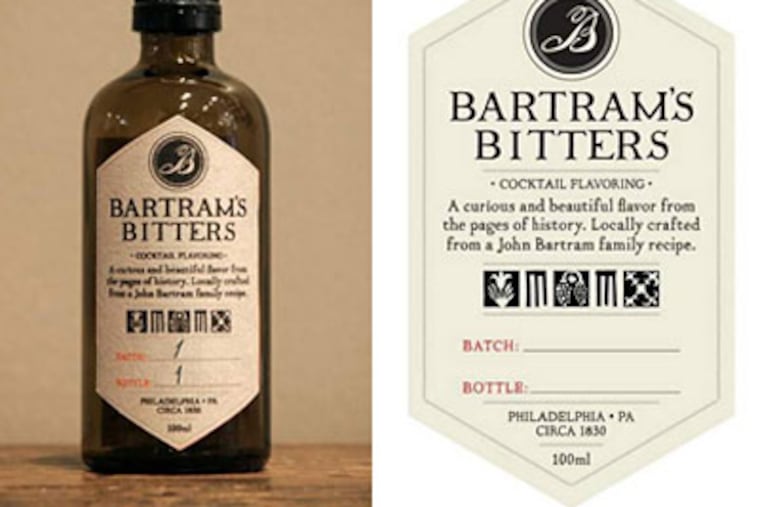Rick Nichols: The resurrection of Bartram's Bitters
Had you stumbled upon the well-scrubbed crowd in the tented courtyard at historic Bartram’s Garden one evening last week, you could not be faulted for thinking you’d discovered a country wedding reception under way beside the old medicinal herb beds. The scene offered requisite trays of passed hors d’oeuvres (a pale sliver of pork over white bean puree seemed popular), and punch bowls scented with strawberry and lemon, and busy cocktail stations.

Had you stumbled upon the well-scrubbed crowd in the tented courtyard at historic Bartram's Garden one evening last week, you could not be faulted for thinking you'd discovered a country wedding reception under way beside the old medicinal herb beds.
The scene offered requisite trays of passed hors d'oeuvres (a pale sliver of pork over white bean puree seemed popular), and punch bowls scented with strawberry and lemon, and busy cocktail stations.
No band, though. And, well, no bride, either. This was a coming-out of another sort: The launch of opaquely brown, modestly proportioned little bottles of what purported to be an approximation of Bartram's Bitters, circa 1830, which may have been (or maybe not, because the record isn't clear) a Philadelphia favorite in the day.
Dashes of the astringent stuff — it had a rough, woodsy scent — had been assigned to kick up the cocktails. Could it become (again) a Bartram's brand? Make a few bucks for the fledgling orchard project?
No one was certain how it would perform. The first 25-gallon batch, after steeping for three weeks, had been bottled only hours before.
It had been re-created by Rob Cassell, the distiller at the spirits company that makes top-shelf Bluecoat Gin. Part of its bite would come, presumably, from bark whittled (by a Drexel intern) from prickly ash found on the property — settled in 1728 — that runs up a leafy, storm-tattered slope from the lower reaches of the Schuylkill.
The garden's staff, always alert to ways to raise the profile of the hidden (at 54th Street and Lindbergh Boulevard in Southwest Philadelphia) homestead of John Bartram, the great 18th-century botanist, had come into possession of the bitters recipe by a fluke.
A folded sheet of paper had slipped out from under the cover of an 1846 edition of A.B. Strong's The American Flora, or History of Plants and WildFlowers. In handwriting that may (or may not) have been that of Bartram's great-grandson, it listed a recipe for Bartram's Homestead Bitters that included imported gentian root, "orange peal," wild cherry twigs, and prickly ash, also known as toothache tree for its bark's gum-numbing qualities.
If the recipe seemed like a road map at first, the going soon got murky. What exactly did it mean by "proof spirits"? (Cassell inferred that might — or might not — mean rum, given the city's once-lively trade with the Caribbean)
The botanicals, some supplied by Fair Foods Philly, were to be "ground fine." But how fine? Calamus root was listed. But it's in the doghouse these days, suspected of increasing cancer risk. It was scratched.
Most critically, there was the question of a second set of instructions penned beneath the initial recipe. They called for caraway and bitter almond, sassafras, and wintergreen, then sugars and coloring from roasted Indian corn, and gallons of water.
Were they part and parcel of the bitters recipe itself? Even a casual reading seems to suggest that they were.
But as he struggled to create the first batch, Cassell chose to ignore those instructions, suspecting — though he is now less confident — that they might be a separate, unrelated formula.
Thus, the first-run bitters don't include the aromatics, sugars, coloring, or diluting water, possibly a reason it lacks the fruity bouquet, say, of Peychaud's, the New Orleans bitters of similar vintage.
In any event, if the Bartram's bitters' truth wasn't easy to pin down, the social history of the bitters fad was more easily deciphered. Joel T. Fry, a Bartram historian, wrote about that phenomenon in 1995 shortly after the recipe first surfaced.
The ancients long used astringent plant extracts as folk remedies, he noted. But the ready-made, highly alcoholic potion that became known as commercial bitters was a uniquely American product — and strong drink hiding in a patent medicine bottle. Its heyday would last from the 1850s until the anti-quackery Pure Foods Act of 1906 doomed most brands. (By that time, one Pittsburgh blend — Hostetter's Stomach Bitters — had raked in more than $1 million yearly, promising to cure dyspepsia, colic, diarrhea, and "bilious complaints.")
Labels appealed unashamedly to patriotism and purity. There were Congress Bitters, Constitution Bitters, Quaker Bitters, and scores of others, all with distinctive bottles.
The handful of domestic survivors — New York's Fee Brothers and Peychaud's, for two — made a different appeal, marketing bitters as cocktail flavorings. And that's all the revamped Bartram's Bitters is promising as well.
At the balmy debut lastweek, 75 well-wishers sipped a white whiskey cocktail from Dettera Restaurant, a lemony gin number from Fish, and bartender Phoebe Esmon's garden-party vodka punch, smoothed with orange blossom green tea.
Was that a hint of bitters up to mischief in their background?
It was hard to tell. It may have been. And then again …
Philadelphia Distilling is selling Bartram's Bitters for $9.99 at the distillery, 12285 McNulty Rd. It is donating $2 from each sale to Bartram's Garden. The bitters will also be offered at the Pennsylvania Liquor Control Board's online store.